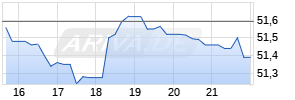
Alliant Energy Announces 2019 Results
PR Newswire
MADISON, Wis., Feb. 20, 2020
MADISON, Wis., Feb. 20, 2020 /PRNewswire/ -- Alliant Energy Corporation (NASDAQ: LNT) today announced U.S. generally accepted accounting principles (GAAP) and non-GAAP consolidated unaudited earnings per share (EPS) for 2019 and 2018 as follows:

| | GAAP EPS | | Non-GAAP EPS | ||||
| | 2019 | | 2018 | | 2019 | | 2018 |
| Utilities and Corporate Services | $2.22 | | $2.08 | | $2.22 | | $2.06 |
| American Transmission Company (ATC) Holdings | 0.14 | | 0.12 | | 0.12 | | 0.12 |
| Non-utility and Parent | (0.03) | | (0.01) | | (0.03) | | (0.01) |
| Alliant Energy Consolidated | $2.33 | | $2.19 | | $2.31 | | $2.17 |
"In 2019, we once again delivered solid financial and operational results. Consistent with our 5-7% long-term earnings growth goal, our temperature-normalized non-GAAP earnings per share increased 7% over calendar year 2018," said John Larsen, Alliant Energy Chairman, President and CEO. "We're putting renewable energy to work for our customers by advancing our renewable energy investments and preparing the energy grid for more distributed energy resources."
Utilities and Corporate Services - Alliant Energy's Utilities and Alliant Energy Corporate Services, Inc. (Corporate Services) operations generated $2.22 per share of GAAP EPS in 2019, which was $0.14 per share higher than 2018. The primary drivers of higher EPS were higher earnings due to Interstate Power and Light Company's (IPL's) and Wisconsin Power and Light Company's (WPL's) increasing rate base. This item was partially offset by higher depreciation expense, higher interest expense and equity dilution.
Non-utility and Parent - Alliant Energy's Non-utility and Parent operations generated $(0.03) per share of GAAP EPS in 2019, which was $0.02 per share lower than 2018. The primary driver of lower EPS was higher interest expense.
Earnings Adjustments - Non-GAAP EPS for 2019 excludes earnings of $0.02 per share related to ATC return on equity (ROE) reserve adjustments due to a Federal Energy Regulatory Commission decision in the fourth quarter of 2019 regarding Midcontinent Independent System Operator, Inc. transmission owners' authorized ROE. Non-GAAP EPS for 2018 excludes earnings of $0.02 per share related to Federal Tax Reform adjustments as a result of clarifying rules issued in 2018. Non-GAAP adjustments, which relate to material charges or income that are not normally associated with ongoing operations, are provided as a supplement to results reported in accordance with GAAP.
Temperature Impacts to Non-GAAP EPS - The estimated net impacts of temperatures on retail electric and gas sales were $0.05 per share and $0.06 per share gains in 2019 and 2018, respectively. The temperature-normalized non-GAAP EPS was $2.26 and $2.11 for fiscal years 2019 and 2018, respectively.
Details regarding GAAP EPS variances between 2019 and 2018 for Alliant Energy are as follows:
| | 2019 | | 2018 | | Variance | |||
| Higher revenue requirements primarily due to increasing rate base | | | | | $0.55 | |||
| Higher depreciation expense | | | | | (0.19) | |||
| Higher interest expense | | | | | (0.08) | |||
| Equity dilution | | | | | (0.06) | |||
| ATC ROE reserve adjustments | 0.02 | | — | | 0.02 | |||
| Tax return adjustments due to Federal Tax Reform | — | | 0.02 | | (0.02) | |||
| Net temperature impact on retail electric and gas sales | 0.05 | | 0.06 | | (0.01) | |||
| Other | | | | | (0.07) | |||
| Total Alliant Energy Consolidated | | | | | $0.14 | |||
Higher revenue requirements primarily due to increasing rate base - In March 2019, IPL filed a request with the Iowa Utilities Board (IUB) to increase annual rates for its Iowa retail electric customers by $204 million, based on a 2020 forward-looking test period. IPL concurrently filed for interim retail electric rates based on 2018 historical data adjusted for certain known and measurable changes occurring in the first quarter of 2019. An interim retail electric rate increase of $90 million, on an annual basis, was implemented effective April 2019. In October 2019, IPL filed a partial settlement agreement with the IUB to increase annual rates for its Iowa retail electric customers by $127 million. This settlement agreement was approved by the IUB in January 2020. As part of this agreement, IPL will refund $8 million of 2019 interim rates in 2020. IPL recognized $0.34 per share of higher electric margins in 2019 due to retail electric rate increases, including the interim refund agreed to as part of the settlement.
In December 2018, WPL received an order from the Public Service Commission of Wisconsin approving WPL's proposed settlement for its retail electric and gas rate review covering the 2019/2020 Test Period, effective January 1, 2019. Under the settlement, WPL's retail electric and gas base rates will not change from current levels through the end of 2020. The $61 million retail electric revenue requirement increase for 2019, resulting from increasing investments in rate base, was offset by lower fuel-related costs and federal tax reform refunds. WPL recognized $0.21 per share of higher electric margins from increasing investments in rate base in 2019.
Net temperature impact of electric and gas sales - Alliant Energy's retail electric and gas sales increased in 2019 and 2018 due to impacts of temperatures on customer demand.
WPL's recent retail electric and gas rate orders included an earnings sharing mechanism whereby WPL must defer a portion of its earnings and return this amount to its retail electric and gas customers if its annual regulatory return on common equity exceeds 10.25%. As a result, a portion of the higher margins recognized at WPL due to the temperature impact on retail electric and gas sales in 2019 and 2018 is expected to be returned to customers in the future.
A portion of Alliant Energy's performance pay is based on earnings. As a result, a portion of the higher earnings resulting from the temperature impact on retail electric and gas sales in 2019 and 2018 was offset by higher performance pay expense. Alliant Energy's estimated temperature impact on retail electric and gas sales, net of the WPL earnings sharing mechanism and the portion of performance pay associated with temperature impacts on earnings, was estimated to be a $0.05 per share and $0.06 per share increase in earnings for 2019 and 2018, respectively.
2020 Earnings Guidance
Alliant Energy's consolidated EPS guidance of $2.34 to $2.48 for 2020 remains unchanged. Drivers for Alliant Energy's 2020 earnings guidance include, but are not limited to:
- Ability of IPL and WPL to earn their authorized rates of return
- Stable economy and resulting implications on utility sales
- Normal temperatures in its utility service territories
- Execution of cost controls
- Execution of capital expenditure and financing plans
- Consolidated effective tax rate of (11%)
The 2020 earnings guidance does not include the impacts of any material non-cash valuation adjustments, regulatory-related charges or credits, reorganizations or restructurings, future changes in laws, regulations or regulatory policies, adjustments made to deferred tax assets and liabilities from valuation allowances, adjustments related to guarantees, pending lawsuits and disputes, federal and state income tax audits and other Internal Revenue Service proceedings, or changes in GAAP and tax methods of accounting that may impact the reported results of Alliant Energy.
"The customers and the communities we serve will continue to benefit from reliable, affordable, cleaner energy as a result of our strong pipeline of investments in renewable energy, and electric and gas distribution. Our 2020 earnings guidance of $2.34 to $2.48 per share is consistent with our long-term growth objective of 5% to 7% annually," said Larsen.
Earnings Conference Call
A conference call to review the 2019 results is scheduled for Friday, February 21st at 9:00 a.m. central time. Alliant Energy Chairman, President and Chief Executive Officer John Larsen, and Executive Vice President and Chief Financial Officer Robert Durian will host the call. The conference call is open to the public and can be accessed in two ways. Interested parties may listen to the call by dialing 888-394-8218 (United States or Canada) or 323-794-2149 (International), passcode 4175543. Interested parties may also listen to a webcast at www.alliantenergy.com/investors. In conjunction with the information in this earnings announcement and the conference call, Alliant Energy posted supplemental materials on its website. A replay of the call will be available through February 28, 2020, at 888-203-1112 (United States or Canada) or 719-457-0820 (International), passcode 4175543. An archive of the webcast will be available on the Company's Web site at www.alliantenergy.com/investors for 12 months.
About Alliant Energy Corporation
Alliant Energy is the parent company of two public utility companies - Interstate Power and Light Company and Wisconsin Power and Light Company - and of Alliant Energy Finance, LLC, the parent company of Alliant Energy's non-utility operations. Alliant Energy is an energy-services provider with utility subsidiaries serving approximately 970,000 electric and 420,000 natural gas customers. Providing its customers in the Midwest with regulated electricity and natural gas service is the Company's primary focus. Alliant Energy, headquartered in Madison, Wisconsin, is a component of the S&P 500 and is traded on the Nasdaq Global Select Market under the symbol LNT. For more information, visit the Company's Web site at www.alliantenergy.com.
Forward-Looking Statements
This press release includes forward-looking statements. These forward-looking statements can be identified by words such as "forecast," "expect," "guidance," or other words of similar import. Similarly, statements that describe future financial performance or plans or strategies are forward-looking statements. Such forward looking statements are subject to certain risks and uncertainties that could cause actual results to differ materially from those expressed in, or implied by, such statements. Actual results could be materially affected by the following factors, among others:
- IPL's and WPL's ability to obtain adequate and timely rate relief to allow for, among other things, the recovery of and/or the return on costs, including fuel costs, operating costs, transmission costs, deferred expenditures, deferred tax assets, tax expense, capital expenditures, and remaining costs related to electric generating units (EGUs) that may be permanently closed and certain other retired assets, earning their authorized rates of return, and the payments to their parent of expected levels of dividends;
- federal and state regulatory or governmental actions, including the impact of legislation, and regulatory agency orders;
- the impact of customer- and third party-owned generation, including alternative electric suppliers, in IPL's and WPL's service territories on system reliability, operating expenses and customers' demand for electricity;
- the impact of energy efficiency, franchise retention and customer disconnects on sales volumes and margins;
- the impact that price changes may have on IPL's and WPL's customers' demand for electric, gas and steam services and their ability to pay their bills;
- the ability to utilize tax credits and net operating losses generated to date, and those that may be generated in the future, before they expire;
- the direct or indirect effects resulting from terrorist incidents, including physical attacks and cyber attacks, or responses to such incidents;
- the impact of penalties or third-party claims related to, or in connection with, a failure to maintain the security of personally identifiable information, including associated costs to notify affected persons and to mitigate their information security concerns;
- any material post-closing payments related to any past asset divestitures, including the sale of Whiting Petroleum, which could result from, among other things, indemnification agreements, warranties, parental guarantees or litigation;
- employee workforce factors, including changes in key executives, ability to hire and retain employees with specialized skills, ability to create desired corporate culture, collective bargaining agreements and negotiations, work stoppages or restructurings;
- weather effects on results of utility operations;
- issues associated with environmental remediation and environmental compliance, including compliance with all environmental and emissions permits, the Coal Combustion Residuals rule, future changes in environmental laws and regulations, including federal, state or local regulations for carbon dioxide emissions reductions from new and existing fossil-fueled EGUs, and litigation associated with environmental requirements;
- increased pressure from customers, investors and other stakeholders to more rapidly reduce carbon dioxide emissions;
- the ability to defend against environmental claims brought by state and federal agencies, such as the EPA, state natural resources agencies or third parties, such as the Sierra Club, and the impact on operating expenses of defending and resolving such claims;
- continued access to the capital markets on competitive terms and rates, and the actions of credit rating agencies;
- inflation and interest rates;
- the impact of the economy in IPL's and WPL's service territories and the resulting impacts on sales volumes, margins and the ability to collect unpaid bills;
- the ability to complete construction of wind and solar projects within the cost caps set by regulators and to meet all requirements to qualify for the full level of production tax credits;
- changes in the price of delivered natural gas, purchased electricity and coal due to shifts in supply and demand caused by market conditions and regulations;
- disruptions in the supply and delivery of natural gas, purchased electricity and coal;
- the direct or indirect effects resulting from breakdown or failure of equipment in the operation of electric and gas distribution systems, such as mechanical problems and explosions or fires, and compliance with electric and gas transmission and distribution safety regulations, including regulations promulgated by the Pipeline and Hazardous Materials Safety Administration;
- issues related to the availability and operations of EGUs, including start-up risks, breakdown or failure of equipment, performance below expected or contracted levels of output or efficiency, operator error, employee safety, transmission constraints, compliance with mandatory reliability standards and risks related to recovery of resulting incremental costs through rates;
- impacts that excessive heat, storms or natural disasters have on Alliant Energy's, IPL's and WPL's operations and recovery of costs associated with restoration activities, or on the operations of Alliant Energy's investments;
- Alliant Energy's ability to sustain its dividend payout ratio goal;
- changes to costs of providing benefits and related funding requirements of pension and other postretirement benefits plans due to the market value of the assets that fund the plans, economic conditions, financial market performance, interest rates, life expectancies and demographics;
- material changes in employee-related benefit and compensation costs;
- risks associated with operation and ownership of non-utility holdings;
- changes in technology that alter the channels through which customers buy or utilize Alliant Energy's, IPL's or WPL's products and services;
- impacts on equity income from unconsolidated investments due to further potential changes to ATC LLC's authorized ROE;
- impacts of IPL's future tax benefits from Iowa rate-making practices, including deductions for repairs expenditures, allocation of mixed service costs and state depreciation, and recoverability of the associated regulatory assets from customers, when the differences reverse in future periods;
- the impacts of adjustments made to deferred tax assets and liabilities from changes in the tax laws;
- changes to the creditworthiness of counterparties with which Alliant Energy, IPL and WPL have contractual arrangements, including participants in the energy markets and fuel suppliers and transporters;
- current or future litigation, regulatory investigations, proceedings or inquiries;
- reputational damage from negative publicity, protests, fines, penalties and other negative consequences resulting in regulatory and/or legal actions;
- the effect of accounting standards issued periodically by standard-setting bodies;
- the ability to successfully complete tax audits and changes in tax accounting methods with no material impact on earnings and cash flows; and
- factors listed in the "2020 Earnings Guidance" section of this press release.
For more information about potential factors that could affect Alliant Energy's business and financial results, refer to Alliant Energy's most recent Annual Report on Form 10-K filed with the Securities and Exchange Commission ("SEC"), including the section therein titled "Risk Factors," and its other filings with the SEC.
Without limitation, the expectations with respect to 2020 earnings guidance in this press release are forward-looking statements and are based in part on certain assumptions made by Alliant Energy, some of which are referred to in the forward-looking statements. Alliant Energy cannot provide any assurance that the assumptions referred to in the forward-looking statements or otherwise are accurate or will prove to be correct. Any assumptions that are inaccurate or do not prove to be correct could have a material adverse effect on Alliant Energy's ability to achieve the estimates or other targets included in the forward-looking statements. The forward-looking statements included herein are made as of the date hereof and, except as required by law, Alliant Energy undertakes no obligation to update publicly such statements to reflect subsequent events or circumstances.
Use of Non-GAAP Financial Measures
To provide investors with additional information regarding Alliant Energy's financial results, this press release includes reference to certain non-GAAP financial measures. These measures include the use of (1) income and EPS for the fourth quarter and year ended December 31, 2019 excluding the ATC ROE reserve adjustments; and (2) income and EPS for the year ended December 31, 2018 excluding the tax return adjustments due to Federal Tax Reform. Alliant Energy believes these non-GAAP financial measures are useful to investors because they provide an alternate measure to better understand and compare across periods the operating performance of Alliant Energy without the distortion of items that management believes are not normally associated with ongoing operations, and also provide additional information about Alliant Energy's operations on a basis consistent with the measures that management uses to manage its operations and evaluate its performance. Alliant Energy's management also uses income, as adjusted, to determine performance-based compensation.
In addition, Alliant Energy included in this press release IPL; WPL; Corporate Services; Utilities and Corporate Services; ATC Holdings; and Non-utility and Parent EPS for the fourth quarter and year ended December 31, 2019 and 2018. Alliant Energy believes these non-GAAP financial measures are useful to investors because they facilitate an understanding of segment performance and trends, and provide additional information about Alliant Energy's operations on a basis consistent with the measures that management uses to manage its operations and evaluate its performance.
This press release references year-over-year variances in utility electric margins and utility gas margins. Utility electric margins and utility gas margins are non-GAAP financial measures that are reported and reconciled to the most directly comparable GAAP measure, operating income, in our 2019 Form 10-K.
This press release also includes temperature-normalized non-GAAP EPS for the year ended December 31, 2019 and 2018. Alliant Energy believes this non-GAAP measure is useful to investors because the measure facilitates period-to-period comparison of Alliant Energy's operating performance and provides investors with information on a basis consistent with measures that management uses to assess Alliant Energy's earnings growth rate.
The tax impact adjustments represent the impact of the tax effect of the pre-tax non-GAAP adjustments excluded from non-GAAP net income. The tax impact of the non-GAAP adjustments is calculated based on the estimated consolidated statutory tax rate.
Reconciliations of the non-GAAP financial measures included in this press release to the most directly comparable GAAP financial measures are included in the earnings summaries that follow, and in the case of temperature-normalized non-GAAP EPS, in the press release above.
Note: Unless otherwise noted, all "per share" references in this release refer to earnings per diluted share.
| ALLIANT ENERGY CORPORATION FULL YEAR EARNINGS SUMMARY (Unaudited) | |||||||||||||||||
| | |||||||||||||||||
| The following tables provide a summary of Alliant Energy's results: | |||||||||||||||||
| | |||||||||||||||||
| EPS: | GAAP EPS | | Adjustments | | Non-GAAP EPS | ||||||||||||
| | 2019 | | 2018 | | 2019 | | 2018 | | 2019 Werbung Mehr Nachrichten zur Alliant Energy Aktie kostenlos abonnieren
E-Mail-Adresse
Bitte überprüfe deine die E-Mail-Adresse.
Benachrichtigungen von ARIVA.DE (Mit der Bestellung akzeptierst du die Datenschutzhinweise) -1  Vielen Dank, dass du dich für unseren Newsletter angemeldet hast. Du erhältst in Kürze eine E-Mail mit einem Aktivierungslink. Hinweis: ARIVA.DE veröffentlicht in dieser Rubrik Analysen, Kolumnen und Nachrichten aus verschiedenen Quellen. Die ARIVA.DE AG ist nicht verantwortlich für Inhalte, die erkennbar von Dritten in den „News“-Bereich dieser Webseite eingestellt worden sind, und macht sich diese nicht zu Eigen. Diese Inhalte sind insbesondere durch eine entsprechende „von“-Kennzeichnung unterhalb der Artikelüberschrift und/oder durch den Link „Um den vollständigen Artikel zu lesen, klicken Sie bitte hier.“ erkennbar; verantwortlich für diese Inhalte ist allein der genannte Dritte. Andere Nutzer interessierten sich auch für folgende News | ||||||||




